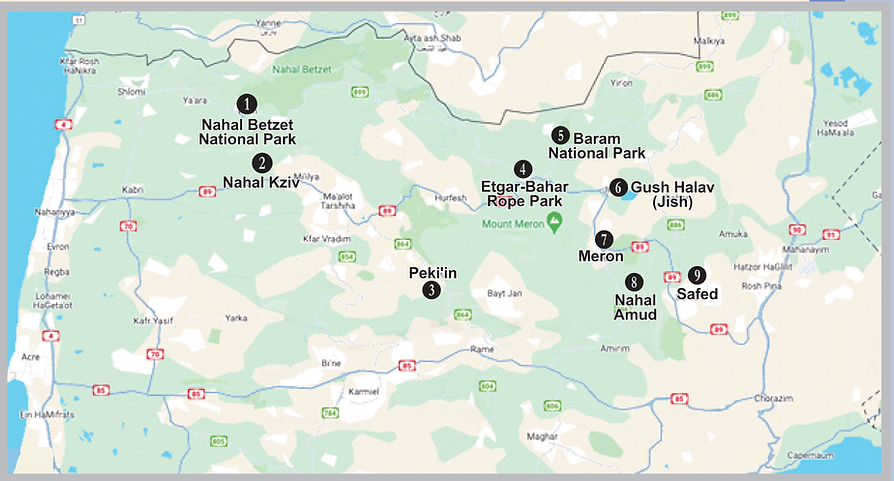About the Upper Galilee with touring map
The Galilee is the mountainous area in the north of Israel extending from the Mount Carmel-Mount Gilboa range in the south up to Israel’s northern border (although geographically up to the east-west section of the Litani River in Lebanon), and from Israel’s coastal plain in the west to the Jordan Rift Valley in the east (including Lake Kinneret and the Hulah Valley).
Traditionally, the Galilee is divided into the northern Upper Galilee and southern Lower Galilee, with the dividing line being the Beit Hakerem Valley. The city of Karmiel is between the two, being in the Beit Hakerem Valley. The Lower Galilee has low mountain ranges less than 2,000 feet with shallow expanses between them, while the mountains in the Upper Galilee reach up to more than 3,000 feet and have sharper valleys.
This website does not cover the coastal plain as this can be considered a separate vacation area. The “Upper Galilee” (in brown on this website) and “Lower Galilee” (in green) are covered separately. All sites north of Lake Kinneret, including those on its northern shore, are described in the section “Eastern Upper Galilee” (in purple). I did this because all places in the Rift Valley north of Lake Kinneret group naturally together as a tourist area. All other sites on Lake Kinneret are described in the section “Lake Kinneret and Jordan Valley” (in light blue). For the same reason, namely because they go together as a tourist area, sites in the Harod Valley and Eastern Jezreel Valley are also described in the section “Lake Kinneret and Jordan Valley,” although geographically they could be considered part of the Lower Galilee. Megiddo in the western part of the Jezreel Valley is covered in the “Lower Galilee” section.
The must-have guide for exploring in and around Jerusalem
"In and Around Jerusalem for Everyone - The Best Walks, Hikes and Outdoor Pools"
For FREE, speedy, home, courier service from Pomeranz Booksellers in Jerusalem click here (tel: 02-623 5559) and for Amazon click here. To view outstanding reviews click here.
Copyright: Dolní_Galilea.svg: Daniel Baránekderivative work: TheCuriousGnome, CC BY 3.0 <https://creativecommons.org/licenses/by/3.0>, via Wikimedia Commons
Jews in the Galilee
The Lower Galilee experienced a large influx of Jews after the Bar Kochba Revolt. Judea was depopulated after the Bar Kochba Revolt and its Jewish population was murdered, sold into slavery, died from starvation or forced to immigrate. However, a sizable proportion of the population managed to escape to the Lower Galilee, including the rabbinic leadership. In many parts of the Lower Galilee almost all the hilltops would be Jewish settlements.
Usha, Shefaram, Beit She'arim, Tzippori, and finally Tiberias, became the seat of the Sanhedrin. This Sanhedrin was not the full Sanhedrin as it had been in Jerusalem, but a group of rabbis who addressed the problems of the Jewish communities and who determined the direction of the Jewish Oral Law. Usha, Shefarim and Beit She'arim were totally Jewish cities, but Tzippori was a mixed pagan and subsequently Christian city, although its administration was Jewish for much of this time. Tiberias was also a mixed city, but it became the seat of Jewish scholarship. During the Byzantine period, and with further Christianization of the country, many Jews moved further north to the Upper Galilee and Golan Heights to predominantly Jewish areas.
What is there to do in the Upper Galilee? First, head to Safed for a day. There is much to see there. Consider also half a day in Pekin. It’s a delightful place and there are nearby places to visit. I also describe four excellent hikes - Nahal Amud and Nahal Betzet are not difficult and are both suitable for a family hike. Nahal Tsalmon is very easy, but shorter than these two other hikes. Nahal Kziv is spectacular, but the return stretch of the circular hike I describe is slightly difficult and not suitable for younger children. To make it easier, you can return the way you came. For a relaxing trip, visit the synagogue of Baram.
Sites in the Upper Galilee

1. Nahal Betzet National Park; 2. Nahal Kziv; 3. Peki’in; 4. Etgar-Bahar Rope Park; 5. Baram National Park; 6. Gush Halav (Jish); 7. Meron; 8. Nahal Amud; 9. Safed.
Links to the HOME PAGE and best family activities, hikes and historic sites in the GOLAN, EASTERN GALILEE, UPPER GALILEE, LOWER GALILEE, JORDAN VALLEY & LAKE KINNERET, the SHEFELAH, TEL AVIV-YAFFO and surroundings, NORTH of TEL AVIV, and SOUTH of TEL AVIV.
Do you find my website interesting and helpful?
Then you are sure to love my two new books "In and Around Jerusalem for Everyone - The Best Walks, Hikes and Outdoor Pools" and "The Struggle for Utopia - A History of Jewish, Christian and Islamic Messianism". Both books are available on Amazon and in Jerusalem bookstores. Click on each of the titles for information, reviews and purchase information.